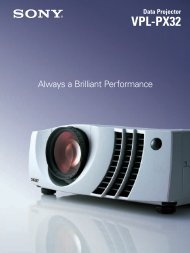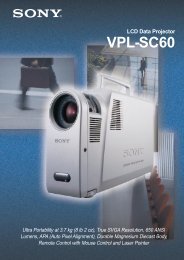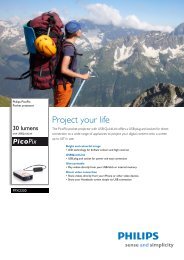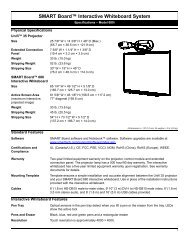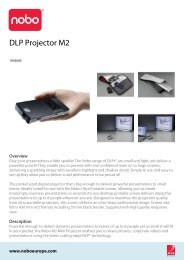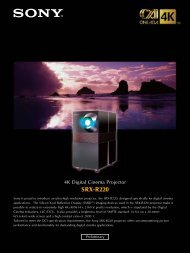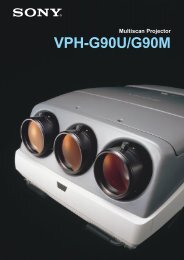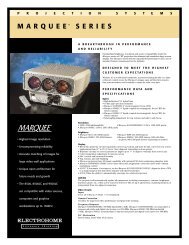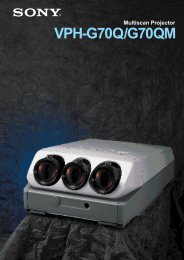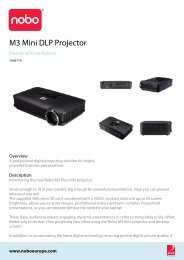DILA Tech Guide.qxd - BigScreen.se
DILA Tech Guide.qxd - BigScreen.se
DILA Tech Guide.qxd - BigScreen.se
Create successful ePaper yourself
Turn your PDF publications into a flip-book with our unique Google optimized e-Paper software.
Comparison with Competitive Systems<br />
Figure 9 shows the composition of current mainstream projection<br />
devices and Table 4 compares the performance of the various<br />
methods with the triple color method. DLP TM switches the double<br />
stable angle of micro-mirrors digitally to modulate the light path and<br />
reproduces tones according to changes in light. Since natural light<br />
is u<strong>se</strong>d as is, high light utilization efficiency can be expected.<br />
However, there is a strong relationship between mirror weight and<br />
the twisted hinge, restricting pixel size flexibility. It is estimated that<br />
the best pixel pitch that can currently be attained is from a few µm<br />
to 20+µm. Shifting to higher resolutions will require larger chip surface<br />
areas and is expected to cau<strong>se</strong> deterioration of pixel yields<br />
and make mass production difficult.<br />
LCDs u<strong>se</strong> transmissive light, so the optical configuration of the system<br />
is relatively simple. Even with a triple system, the device can<br />
easily be made compact and lightweight and low cost can be<br />
attained. On the other hand, since transmissive light <strong>se</strong>ction, the<br />
address lines, signal lines, and drive elements are all laid out on the<br />
same surface, an increa<strong>se</strong> in the number of pixels will decrea<strong>se</strong> the<br />
aperture ratio. Becau<strong>se</strong> in this system, resolution and light output<br />
generally have an inver<strong>se</strong> relationship, it is more appropriate for<br />
mobile and portable units than for ultra-high resolution and ultrahigh<br />
brightness.<br />
Figure 9: Structure of Each Projection Device<br />
D-ILA 0.9": 1,400,000 pixels DMD 1.1": 1,300,000 pixels LCD 1.3" or 1.8": 1,300,000 pixels<br />
Device<br />
• Liquid crystal polarized modulation<br />
• Analog gradation<br />
• U<strong>se</strong>s polarized light (PS composition<br />
is needed)<br />
• Ultra high density<br />
• Ultra high aperture ratio<br />
• Micro mirror angle modulation<br />
• Digital gradation<br />
• U<strong>se</strong>s natural light<br />
• Limited pixel pitch<br />
• High aperture ratio<br />
• Yield difficulty<br />
• Liquid crystal light modulation<br />
• Analog gradation<br />
• U<strong>se</strong>s polarized light (PS composition is<br />
needed)<br />
• Low density<br />
• Low aperture ratio<br />
Optical system<br />
• Reflective type<br />
• Quasi-shurilen <strong>se</strong>paration<br />
• Clo<strong>se</strong> relationship between cone<br />
angle and device angle<br />
(More freedom of F value, High<br />
light efficiency ratio)<br />
• 3P composition<br />
• Middle light path length<br />
• Reflective type<br />
• PBS <strong>se</strong>paration<br />
• Inver<strong>se</strong> relationship between cone<br />
angle and contrast<br />
(Telecen system, Limited F value,<br />
Pha<strong>se</strong> compensation)<br />
• 3P/4P composition<br />
• Long light path length<br />
• Transmissive type<br />
• Polarization plate <strong>se</strong>paration<br />
• Inver<strong>se</strong> relationship between light<br />
amount and temperature of polarization<br />
plate<br />
(Adoption of intake side PBS, Large<br />
device size)<br />
• 4P composition<br />
• Short light path length<br />
High Resolution<br />
Device size comparison for the same resolution<br />
The smaller the size, the higher the resolution<br />
D-ILA<br />
(operable limit)<br />
Single D-ILA made possible<br />
D-ILA can have both high<br />
resolution and high brightness<br />
High Brightness<br />
Available space for device’s light utilization<br />
The larger the size, the higher the brightness<br />
D-ILA<br />
(current model)<br />
DMD<br />
Single-panel color projection<br />
is possible<br />
S-D-ILA<br />
LCD<br />
LCD<br />
DMD<br />
D-ILA<br />
As mentioned above, becau<strong>se</strong> D-ILA TM has pixel densities and<br />
aperture ratios superior to other systems, it is possible to produce<br />
ultra-high light output and ultra-high resolution. Also, by using the<br />
high density characteristic, the size of the pixel chip can be<br />
reduced compared to other units at the same resolution. This<br />
means that this system is applicable to portable and mobile systems.<br />
The D-ILA TM system is considered ideal for the highresolution<br />
era of the 21st century.<br />
8



